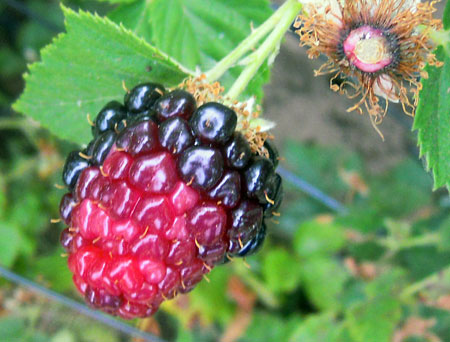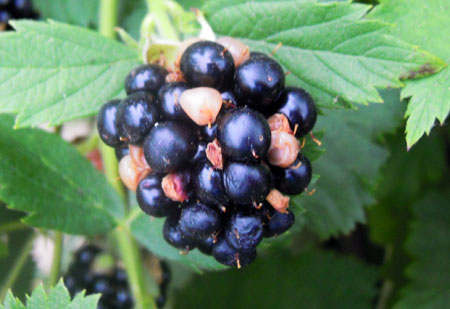Redberry mite damage to blackberries
Identifying and treating redberry mites in blackberries.
Redberry mite injury seems to be uncommon in Michigan, but has shown up on blackberries grown in a high-tunnel planting at the Southwest Michigan Research and Extension Center (SWMREC) this year (2012). This pest is a tiny eriophyid mite that cannot be seen without at least a 20X magnification, but the injury it causes is very noticeable.

Redberry mite damage.
Fruit infested with this mite are inedible and can’t be marketed. The mites inject a toxin into the fruit as they feed. Some drupelets ripen normally and some remain red and hard. The cultivar ‘Chester’ is particularly susceptible, as are other late maturing varieties such as ‘Triple Crown,’ ‘Navaho’ and ‘Apache.’ Redberry mites overwinter under bud scales on blackberry canes and move to flowers in the spring to attack developing fruit. Sunscald could be confused with injury from redberry mites, but affected drupelets are white, not red, and eventually become dry. Sunscald is caused by high temperatures and intense afternoon sunlight.

Blackberry sunscald.
Once symptoms appear, treatments are not effective, but applications can be planned for the following year. For plantings where this pest has been a problem, a delayed-dormant application of sulfur or lime-sulfur after bud break in addition to an application when shoots are 2 to 6 inches long has been recommended in the northwest states. Research at University of California has shown that several applications of horticultural oil spaced two to three weeks apart after green fruit stage may also provide control with less injury to fruit yields than sulfur or lime-sulfur applications.
If you have not used horticultural oils on your blackberry plantings before, it would be prudent to test it on a small portion of the planting first to check for possible phytotoxicity. Oils should not be applied within one month of a sulfur application to avoid phytotoxicity. Oils should also not be applied when temperatures exceed 90 degrees, which limits their use in high tunnels.



 Print
Print Email
Email


